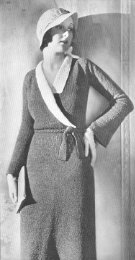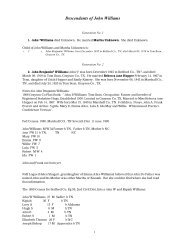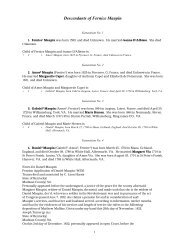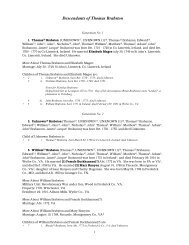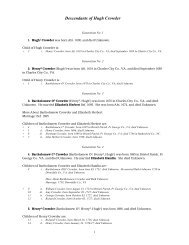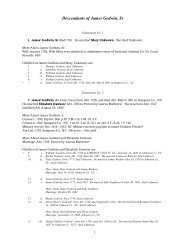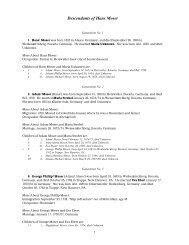Family Tree Maker - Cemetarian
Family Tree Maker - Cemetarian
Family Tree Maker - Cemetarian
Create successful ePaper yourself
Turn your PDF publications into a flip-book with our unique Google optimized e-Paper software.
longingly as his beloved plays the keys of an early piano “the virginals”.<br />
Courtesy of Kari Boyd McBride:<br />
Aemilia Lanyer was christened at St. Botolph, Bishopsgate--the London neighborhood where "foreign<br />
musicians and theatre-folk lived"--on January 27, 1569 (Rowse 13). She was the daughter of Baptista<br />
Bassano and Margaret Johnson. Nothing certain is known of Lanyer's mother but that she was buried in<br />
Bishopsgate on July 7, 1587 (Rowse 14). But it is possible that she was the Margaret Johnson born ca.<br />
1545-1550 who was the aunt of Robert Johnson (1583?-1633), lutenist and composer, musician of<br />
Shakespeare's company, and, later, musician to the court of Charles I (DNB s.v. "Robert Johnson";<br />
Woods, Lanyer, 3-4). Lanyer's father's family, the Bassanos, were court musicians who had come to<br />
England from Venice at the end of Henry VIII's reign. It has been argued that they were converted Jews<br />
(Lasocki and Prior; Rowse, "Revealed at Last," and ensuing correspondence; Greer et al., s.v. "Aemilia<br />
Lanyer"), but Ruffatti has argued persuasively that the family was Christian. Lanyer had an elder sister,<br />
Angela (d. 1584), and two brothers, Lewes and Phillip, who did not survive to adulthood (Lasocki and<br />
Prior 46). Lanyer's father died when she was seven and was also buried in Bishopsgate, on May 11,<br />
1576 (Rowse 14). Internal evidence of Lanyer's poems tell us that she was fostered in the household of<br />
Susan Bertie Wingfield, Countess Dowager of Kent (information also confirmed by Forman), and that<br />
she was later attached to the household of Margaret, Countess of Cumberland, and her daughter, Anne<br />
Clifford. Lanyer memorializes her time with them at the estate of Cookham Dean in "The Description of<br />
Cooke-ham." Lanyer must have been educated along with the noble girls whom she attended, for her<br />
work shows familiarity with poetic genres and verse forms and with the (Geneva) Bible (McBride,<br />
Engendering Authority, "Appendix").<br />
As a young woman, Lanyer frequented the court of Elizabeth I and was mistress to Henry Carey, Lord<br />
Hunsdon, forty-five years her senior, who "maintained [her] in great pomp," says Forman, and provided<br />
her with an income of forty pounds a year (Rowse 11). (There is no conclusive evidence that Lanyer was<br />
William Shakespeare's mistress, an argument advanced by Rowse, nor, indeed, that she was the "darkeyed<br />
lady" of Milton's sonnets, a theory advanced early in this century by John Smart.) She became<br />
pregnant at the age of twenty-three, was paid off by Hunsdon, and married her cousin by marriage,<br />
Alphonso Lanyer, a Queen's musician, on October 10, 1592 (Lasocki and Prior 106, 102). The Lanyers<br />
were from Rouen and had come to England under Elizabeth (Rowse 14). Alphonso was a member of the<br />
recorder consort originally started by the five Bassano brothers that included Lanyer's father, Baptista.<br />
(Indeed, Alphonso was the recipient of the royal stipend that had once been Baptista's [Lasocki and<br />
Prior 147].) Alphonso served as gentleman volunteer in the Essex Islands Voyage of 1597 and had also<br />
done service in Ireland (Lewalski, "God" 205; Rowse 11; Woods 213). He was one of fifty-nine<br />
musicians who played at Elizabeth's funeral, and he moved at her death into the service of James I<br />
(Rowse 18). He had been preferred by Elizabeth's closest advisor, William Cecil, Lord Burghley, and<br />
granted a monopoly for the weighing of hay and straw in London (six pence for every load of hay and<br />
three pence for every load of straw brought into London and Westminster) (Rowse 19; Lasocki and<br />
Prior 108-09). When he died in 1613, Aemilia Lanyer made over the grant to her brother-in-law,<br />
Innocent, evidently with an understanding that she would continue to receive a portion of it, though her<br />
right to that income was a source of later dispute.<br />
Lanyer told Forman that she had suffered many miscarriages (Rowse 11), but she had at least two<br />
children: the first (presumably the son of Hunsdon) named Henry, born early in 1593, and a daughter,<br />
Odillya, born in December of 1598, who died at ten months of age and was buried at St. Botolph's,<br />
Bishopsgate (Rowse 11, 15; Woods 213). Henry became one of the king's flautists on September 29,<br />
1629. He had two children by his wife, Joyce Mansfield, whom he married in 1623: Mary, baptized July<br />
25, 1627, and Henry, baptized January 16, 1630. The children may have been orphaned on Henry's<br />
death in October 1633. At any rate, Lanyer says in 1635 that she has "two grandchildren to provide for"<br />
(Rowse 35).<br />
Lanyer first consulted Simon Forman, the astrologer, on May 17, 1597 (Rowse 11). She was then living<br />
in Longditch, Westminster, next to Canon Row, which Rowse calls "a fashionable quarter full of the<br />
houses of grandees" (13-14). Forman provides the only physical description we have of Lanyer--that she<br />
had a wart or mole in the pit of her throat (Rowse 12). Lanyer consulted Forman again on June 3 and<br />
16, asking whether her husband would come into any preferment (Rowse 11). Forman reported that she<br />
was unhappy with her husband who had "dealt hardly with her" and "spent and consumed her goods"<br />
(Rowse 12). Forman thought her (supposed) emotional and financial neediness would make her "a good<br />
fellow," that is, a willing sex partner, but, though she seems to have had continued contact with Forman<br />
over the next few years and may have engaged in sexual play with him, she refused to have intercourse,<br />
prompting him to wonder "whether or not she is an incuba" and to call her a whore (Rowse 12, 13).<br />
Lanyer published her volume of poetry, Salve Deus Rex Judaeorum (Hail, God, King of the Jews), in<br />
1611, when she was forty-two years old. All the poems are in iambic pentameter, though the verse forms<br />
vary. Two prefatory pieces and an afterword are prose. "The Description of Cooke-ham" must have been<br />
2




